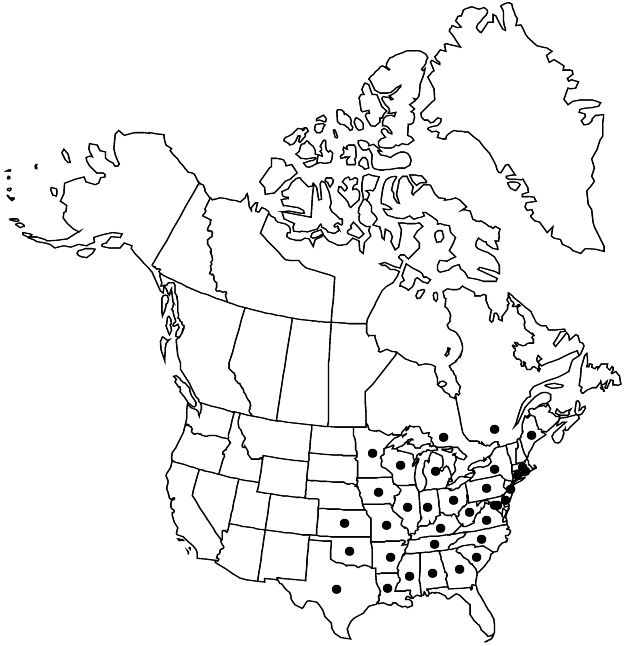Difference between revisions of "Paronychia fastigiata"
Rhodora 38: 421. 1936.
FNA>Volume Importer |
RevisionBot (talk | contribs) m (Bot: Adding category Revised Since Print) |
||
| (4 intermediate revisions by 3 users not shown) | |||
| Line 8: | Line 8: | ||
}} | }} | ||
|common_names=Hairy forked nailwort;forked-chickweed | |common_names=Hairy forked nailwort;forked-chickweed | ||
| + | |special_status={{Treatment/ID/Special_status | ||
| + | |code=E | ||
| + | |label=Endemic | ||
| + | }} | ||
|basionyms={{Treatment/ID/Basionym | |basionyms={{Treatment/ID/Basionym | ||
|name=Anychia fastigiata | |name=Anychia fastigiata | ||
|authority=Rafinesque | |authority=Rafinesque | ||
| + | |rank=species | ||
|publication_title=Atlantic J. | |publication_title=Atlantic J. | ||
|publication_place=1: 16. 1832 | |publication_place=1: 16. 1832 | ||
| Line 25: | Line 30: | ||
-->{{Treatment/Body | -->{{Treatment/Body | ||
| − | |distribution= | + | |distribution=Ont.;Que.;Ala.;Ark.;Conn.;D.C.;Del.;Ga.;Ill.;Ind.;Iowa;Kans.;Ky.;La.;Maine;Mass.;Md.;Mich.;Minn.;Miss.;Mo.;N.C.;N.J.;N.Y.;Ohio;Okla.;Pa.;R.I.;S.C.;Tenn.;Tex.;Va.;W.Va.;Wis. |
|discussion=<p>Varieties 3 (3 in the flora).</p><!-- | |discussion=<p>Varieties 3 (3 in the flora).</p><!-- | ||
--><p>The varieties here recognized are sympatric over at least portions of their ranges. A detailed study on infraspecific variation within <i>Paronychia fastigiata</i> is warranted.</p> | --><p>The varieties here recognized are sympatric over at least portions of their ranges. A detailed study on infraspecific variation within <i>Paronychia fastigiata</i> is warranted.</p> | ||
| Line 58: | Line 63: | ||
-->{{#Taxon: | -->{{#Taxon: | ||
name=Paronychia fastigiata | name=Paronychia fastigiata | ||
| − | |||
|authority=(Rafinesque) Fernald | |authority=(Rafinesque) Fernald | ||
|rank=species | |rank=species | ||
| Line 65: | Line 69: | ||
|basionyms=Anychia fastigiata | |basionyms=Anychia fastigiata | ||
|family=Caryophyllaceae | |family=Caryophyllaceae | ||
| − | |distribution= | + | |distribution=Ont.;Que.;Ala.;Ark.;Conn.;D.C.;Del.;Ga.;Ill.;Ind.;Iowa;Kans.;Ky.;La.;Maine;Mass.;Md.;Mich.;Minn.;Miss.;Mo.;N.C.;N.J.;N.Y.;Ohio;Okla.;Pa.;R.I.;S.C.;Tenn.;Tex.;Va.;W.Va.;Wis. |
|reference=None | |reference=None | ||
|publication title=Rhodora | |publication title=Rhodora | ||
|publication year=1936 | |publication year=1936 | ||
| − | |special status= | + | |special status=Endemic |
| − | |source xml=https:// | + | |source xml=https://bitbucket.org/aafc-mbb/fna-data-curation/src/2e0870ddd59836b60bcf96646a41e87ea5a5943a/coarse_grained_fna_xml/V5/V5_67.xml |
|subfamily=Caryophyllaceae subfam. Paronychioideae | |subfamily=Caryophyllaceae subfam. Paronychioideae | ||
|genus=Paronychia | |genus=Paronychia | ||
| Line 76: | Line 80: | ||
}}<!-- | }}<!-- | ||
| − | -->[[Category:Treatment]][[Category:Paronychia]] | + | --> |
| + | |||
| + | [[Category:Treatment]] | ||
| + | [[Category:Paronychia]] | ||
| + | [[Category:Revised Since Print]] | ||
Latest revision as of 18:10, 6 November 2020
Plants annual; taproot filiform to slender. Stems erect, usually much-branched, 4–30 cm, retrorsely to spreading-pubescent mostly on 1 side. Leaves: stipules subulate to lanceolate, 0.5–4.5 mm, apex acuminate, sometimes fimbriate; blade usually dotted or blotched, oblanceolate to elliptic or obovate, 2–25 × 0.5–7(–10) mm, herbaceous to leathery, apex subobtuse to acute or cuspidate, glabrous or occasionally with very few scattered trichomes along midrib. Cymes terminal, 25–70+-flowered, branched, loose to compact, forming clusters 3–10 mm wide. Flowers 5-merous, short-cylindric, with enlarged hypanthium and calyx ± cylindric, 1.1–1.6 mm, glabrous or with few scattered hairs; sepals greenish to brownish, veins absent, linear-oblong, 1–1.2 mm, leathery to rigid, margins white to translucent, 0.05–0.1 mm wide, scarious, apex terminated by mucro, hood narrowly rounded, mucro short-conic, 0.05–0.3 mm, ± minutely scabrous; staminodes absent; styles 2, 0.07–0.6(–0.7) mm. Utricles obovoid to obconic, 0.7–1 mm, minutely papillate. 2n = 32, 36.
Distribution

Ont., Que., Ala., Ark., Conn., D.C., Del., Ga., Ill., Ind., Iowa, Kans., Ky., La., Maine, Mass., Md., Mich., Minn., Miss., Mo., N.C., N.J., N.Y., Ohio, Okla., Pa., R.I., S.C., Tenn., Tex., Va., W.Va., Wis.
Discussion
Varieties 3 (3 in the flora).
The varieties here recognized are sympatric over at least portions of their ranges. A detailed study on infraspecific variation within Paronychia fastigiata is warranted.
Selected References
None.
Lower Taxa
Key
| 1 | Styles 0.3-0.6(-0.7) mm, often bent or contorted | Paronychia fastigiata var. pumila |
| 1 | Styles 0.07-0.25(-0.3) mm, straight | > 2 |
| 2 | Sepal cusps 0.2-0.3 mm | Paronychia fastigiata var. nuttallii |
| 2 | Sepal cusps 0.05-0.15 mm | Paronychia fastigiata var. fastigiata |